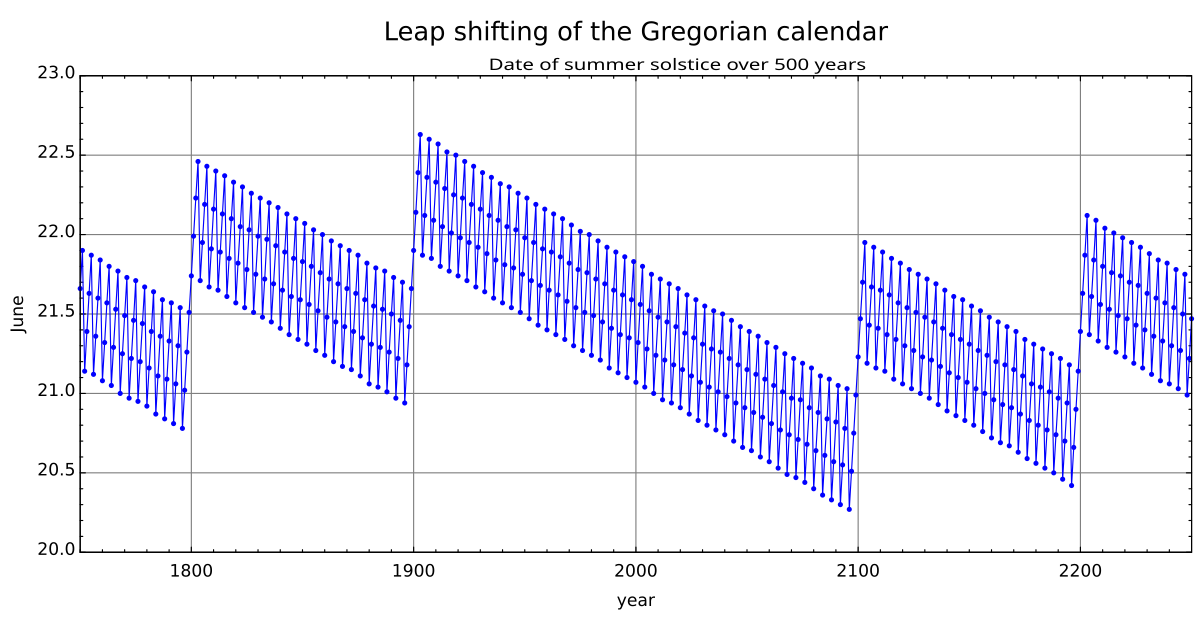cross-posted from: https://lemmy.world/post/19541930
Preferably a Holocene colander?
A consensus view was formally adopted by the IUGS in 2013, placing its start at 11,700 years before 2000 (9701 BC), about 300 years more recent than the epoch of the Holocene calendar.[6]
Some problems with Gregorian calendar
The Gregorian calendar improves the approximation made by the Julian calendar by skipping three Julian leap days in every 400 years, giving an average year of 365.2425 mean solar days long.[82] This approximation has an error of about one day per 3,030 years[s] with respect to the current value of the mean tropical year. However, because of the precession of the equinoxes, which is not constant, and the movement of the perihelion (which affects the Earth's orbital speed) the error with respect to the astronomical vernal equinox is variable; using the average interval between vernal equinoxes near 2000 of 365.24237 days[83] implies an error closer to 1 day every 7,700 years. By any criterion, the Gregorian calendar is substantially more accurate than the 1 day in 128 years error of the Julian calendar (average year 365.25 days).
In the 19th century, Sir John Herschel proposed a modification to the Gregorian calendar with 969 leap days every 4,000 years, instead of 970 leap days that the Gregorian calendar would insert over the same period.[84] This would reduce the average year to 365.24225 days. Herschel's proposal would make the year 4000, and multiples thereof, common instead of leap. While this modification has often been proposed since, it has never been officially adopted.[85]
On time scales of thousands of years, the Gregorian calendar falls behind the astronomical seasons. This is because the Earth's speed of rotation is gradually slowing down, which makes each day slightly longer over time (see tidal acceleration and leap second) while the year maintains a more uniform duration.
Calendar seasonal error Gregorian calendar seasons difference
This image shows the difference between the Gregorian calendar and the astronomical seasons.
The y-axis is the date in June and the x-axis is Gregorian calendar years.
Each point is the date and time of the June solstice in that particular year. The error shifts by about a quarter of a day per year. Centurial years are ordinary years, unless they are divisible by 400, in which case they are leap years. This causes a correction in the years 1700, 1800, 1900, 2100, 2200, and 2300.
For instance, these corrections cause 23 December 1903 to be the latest December solstice, and 20 December 2096 to be the earliest solstice—about 2.35 days of variation compared with the astronomical event.
Proposed reforms The following are proposed reforms of the Gregorian calendar:
Holocene calendar
International Fixed Calendar (also called the International Perpetual calendar)
World Calendar
World Season Calendar
Leap week calendars
Pax Calendar
Symmetry454
Hanke–Henry Permanent Calendar



I prefer the way Mars lacks a calendar. Due to us placing a lot of stuff there, we need to refer to dates. Basically, the system just refers to days as Sol, and each individual date is Sol 1, Sol 2, and so forth until the end of the year. I don't see why this wouldn't work on other planets as well. Months don't really serve a practical function anyway.
I think months, or some grouping of days is very useful. It's harder to understand something like "days 90-120 in the northern hemisphere are usually good times to plant seed" or "I love the weather in New England around days 240-280". Months and seasons give context faster than doing some internal mapping of day numbers.
Green Day probably wouldn't be happy about rewriting their song to "Wake Me Up When Days 244 to 273 Have Ended" either.
Seasons still play a part. While Green Day would have to sort out the cadence for the rewrite, referring to fall would make sense instead.
They'd have to triple their sleep though.
If they can sleep for one month, they can sleep for three
What's a month? ;)
I like it. Months are useful on Earth, but their absence in other planets' calendars will go a long way to simplify things. Seasons can remain a function of Sols with periodic corrections over centuries to account for rotational speed changes.
Are they? I've found them to be the least useful division of time. They don't line up with the days of the week, or the phases of the moon, or the seasons, and you need a mnemonic to remember which ones have 28, 30, or 31 days. Now if we had 13 months, each with 28 days, that could be a bit more useful...
It makes budgeting easier, for one. But it's just a really arbitrary way to have a measure when a week is too little and a season / year too much.
I suppose so, but it would be even easier if months all had a fixed number of days, wouldn't it?
those damn romans, man...
one month would need to be more flexible for the division remain and leap years, but it would I suppose.
They've already got a plan for this. 13 months, each with 28 days (four weeks), gives us 364 days. New Years Day and Leap Year Day are added as extra holidays which are outside of the named day/month system.